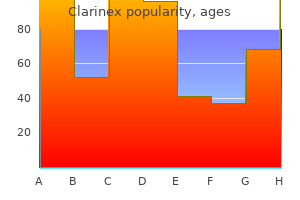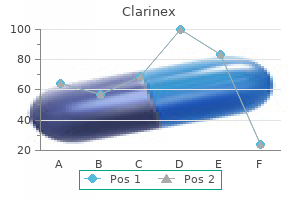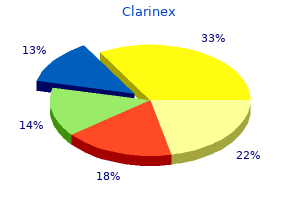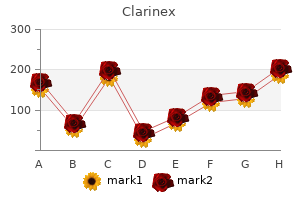
Clarinex
| Contato
Página Inicial

"5 mg clarinex, allergy treatment bangalore".
L. Armon, M.A., M.D., Ph.D.
Associate Professor, Tulane University School of Medicine
To reduce the impression of this on medical decision making allergy medicine xanax clarinex 5 mg discount amex, some states with public outcomes reporting have employed both systematic exclusions for shock patients or those with anoxic brain damage allergy testing yahoo cheap clarinex 5 mg on-line, while others have tried to incorporate high-risk options into multivariable threat adjustment algorithms allergy shots rush immunotherapy clarinex 5 mg purchase overnight delivery. Nonetheless allergy essential oils clarinex 5 mg generic on line, public reporting has been linked to avoidance of procedures in this high-risk inhabitants, and this has been linked to antagonistic outcomes. Vasopressors are often required, particularly within the setting of therapeutic hypothermia. In the specific setting of cardiogenic shock after cardiac arrest, inotropes including dobutamine and milrinone could additionally be essential. However, each of these brokers trigger vasodilation, and dobutamine may cause tachycardia. Revascularization ought to be carried out if cardiogenic shock is current and offender vessels are identified. These units are most efficacious if positioned early within the shock cycle (eg, previous to percutaneous coronary intervention). Determining during which patients to employ these advanced therapies is usually complicated by the uncertain neurologic standing of the postarrest affected person, as neurologic restoration can usually take a couple of days. Effectiveness of implantable defibrillators for stopping arrhythmic occasions and death: a meta-analysis. The objectives of hospital care are instituting supportive care so as to protect organ function (especially cerebral function), identifying the trigger of the arrest, and optimizing therapy of this underlying cause. Frequency of lively coronary lesions, inactive coronary lesions, and myocardial infarction. Part 1: government summary: 2010 American Heart Association pointers for cardiopulmonary resuscitation and emergency cardiovascular care. Chest compression rates throughout cardiopulmonary resuscitation are suboptimal: a potential research throughout in-hospital cardiac arrest. Minimally interrupted cardiac resuscitation by emergency medical providers for out-of-hospital cardiac arrest. Chest-compression-only versus standard cardiopulmonary resuscitation: a meta-analysis. Death by hyperventilation: a standard and life-threatening problem throughout cardiopulmonary resuscitation. Mechanical versus handbook chest compressions in out-of-hospital cardiac arrest: a meta-analysis. Impact of impedance threshold gadgets on cardiopulmonary resuscitation: a scientific evaluate and metaanalysis of randomized controlled studies. Treatment of monitored outof-hospital ventricular fibrillation and pulseless ventricular tachycardia utilising the precordial thump. Delaying defibrillation to give primary cardiopulmonary resuscitation to patients with out-of-hospital ventricular fibrillation: a randomized trial. Defibrillation or cardiopulmonary resuscitation first for sufferers with out-of-hospital cardiac arrests discovered by paramedics to be in ventricular fibrillation Part 5: grownup fundamental life assist: 2010 American Heart Association tips for cardiopulmonary resuscitation and emergency cardiovascular care. Effects of interrupting precordial compressions on the calculated chance of defibrillation success during out-of-hospital cardiac arrest. Public entry defibrillation in outof-hospital cardiac arrest: a community-based examine. Prehospital epinephrine use and survival among patients with out-ofhospital cardiac arrest. Outcomes after outof-hospital cardiac arrest handled by primary vs advanced life support. A comparability of standard-dose and high-dose epinephrine in cardiac arrest outdoors the hospital. A comparability of repeated excessive doses and repeated normal doses of epinephrine for cardiac arrest exterior the hospital. Part 8: grownup advanced cardiovascular life support: 2010 American Heart Association tips for cardiopulmonary resuscitation and emergency cardiovascular care. A comparability of vasopressin and epinephrine for out-of-hospital cardiopulmonary resuscitation. Vasopressin, steroids, and epinephrine and neurologically favorable survival after inhospital cardiac arrest: a randomized clinical trial. Amiodarone for resuscitation after out-of-hospital cardiac arrest as a result of ventricular fibrillation. Amiodarone as compared with lidocaine for shock-resistant ventricular fibrillation. Atropine sulfate for patients with out-of-hospital cardiac arrest as a end result of asystole and pulseless electrical exercise. Prehospital transcutaneous cardiac pacing for symptomatic bradycardia or bradyasystolic cardiac arrest: a scientific review. Temporal trends in sudden cardiac arrest: a 25-year emergency medical providers perspective. Outcome of resuscitation from bradyarrhythmic or asystolic prehospital cardiac arrest. Regional methods of look after out-of-hospital cardiac arrest: a policy assertion from the American Heart Association. Implementation methods for bettering survival after out-of-hospital cardiac arrest within the United States: consensus suggestions from the 2009 American Heart Association Cardiac Arrest Survival Summit. Part 9: post-cardiac arrest care: 2010 American Heart Association guidelines for cardiopulmonary resuscitation and emergency cardiovascular care. Early goal-directed hemodynamic optimization combined with therapeutic hypothermia in comatose survivors of out-of-hospital cardiac arrest. Hyperthermia after cardiac arrest is associated with an unfavorable neurologic end result. Targeted temperature administration at 33 degrees C versus 36 levels C after cardiac arrest. Outcome, timing and antagonistic events in therapeutic hypothermia after out-of-hospital cardiac arrest. Induction of therapeutic hypothermia by paramedics after resuscitation from out-of-hospital ventricular fibrillation cardiac arrest: a randomized controlled trial. Effect of prehospital induction of delicate hypothermia on survival and neurological status among adults with cardiac arrest: a randomized medical trial. Cardiac arrest: a therapy algorithm for emergent invasive cardiac procedures in the resuscitated comatose affected person. Association between public reporting of outcomes with procedural management and mortality for patients with acute myocardial infarction. Randomized comparison of intraaortic balloon support with a percutaneous left ventricular help system in sufferers with revascularized acute myocardial infarction difficult by cardiogenic shock. A randomized clinical trial to consider the safety and efficacy of a percutaneous left ventricular assist gadget versus intra-aortic balloon pumping for therapy of cardiogenic shock brought on by myocardial infarction. Cardiopulmonary resuscitation with assisted extracorporeal life-support versus standard cardiopulmonary resuscitation in adults with in-hospital cardiac arrest: an observational examine and propensity evaluation. A comparability of antiarrhythmic-drug therapy with implantable defibrillators in sufferers resuscitated from near-fatal ventricular arrhythmias. Effectiveness of implantable defibrillators for preventing arrhythmic events and dying: a metaanalysis. Life-threatening ventricular arrhythmias due to transient or correctable causes: high threat for dying in follow-up. Amiodarone or an implantable cardioverter-defibrillator for congestive coronary heart failure. Prophylactic implantation of a defibrillator in patients with myocardial infarction and lowered ejection fraction. Prevalence and prognostic significance of ventricular arrhythmias after acute myocardial infarction in the fibrinolytic era. Risk stratification following myocardial infarction in the thrombolytic era: a two-step strategy using noninvasive and invasive strategies.


Parenteral prochlorperazine is the most effective drug for controlling violent ven igo and allergy forecast portland oregon 5 mg clarinex mastercard, omiting allergy test quiz clarinex 5 mg cheap fast delivery. Preanaesthetic medication Promethazine has been used for its anticholinergic and sedative properties allergy forecast sugar land 5 mg clarinex buy overnight delivery. Cough Antihistaminics like chlorpheniramine allergy testing without insurance clarinex 5 mg order with mastercard, diphenhydramine and promethazine are constituents of many in style cough treatments. Parkinsonism Promethazi ne and a few others afford delicate symptomatic relief in early cases- based on anticholinergic and sedative property. Acute muscle dystonia Caused by antidopaminergic-antipsychotic medication is promptly relieved by parenteral promethazine, H2 antagonist the first 8i blocker Burimamide was discovered by Black in 1972. They are primaril y utilized in peptic ulcer, gastroesophageal reflux and different gastric hypersecretory states. He gave history of similar episodes occu rring off and on through the spring season. A diagnosis of seasonal allergic rhinitis was made and the doctor prescribed an oral antiallergic medication to be taken as soon as a day till symptoms subside. If not, can some medications be added to prevent/su bdue the episodes through the vulne rable season. It can be fou nd in wasp and scorpion sting, and is extensively distributed in invertebrates and crops (banana. It can additionally be located in brain, particularly hippocampus and the colliculi the place it causes slow depolarization by decreasing K" conductance. In intact animals, bradycard ia is mostly seen because of activation of coronary chemoreflex (Bezold Jarisch reflex) through motion on vagal afferent nerve endings in the coronary mattress. Peristalsis is increased and diarrhoea can occur additionally as a outcome of elevated secretion). Depolarization of v isceral afferents e licits respiratory and cardiovascular reflexes, nausea and vomiting. Respiration A brief stimulation of respiration (mostly reflex from bronchial afforcnts) and hyperventilation arc the u ual response, however massive doses injected i. Neuroendocrine function the hypothalamic neurones that management release of anteri or pituitary hormones are most likely regulated by serotonergic mechanism. Direct injection within the mind produces sleepiness, modifications in physique temperature, hunger and a selection of behavioural results. T hey constrict cerebral blood vessels and have emerged as the simplest treatment of acute migraine attacks. Introduced briefly for migraine prophylaxis, carcinoid and postgastrectomy dumping syndrome, it went into disuse as a result of it caused abdominal, pulmonary and endocardial fibrosis. Like the latter, it particularly ameliorates unfavorable symptoms of schizophrenia, but produces extrapyramidal unwanted effects. Painful dry gangrene of palms and toes which become b lack (as if burnt) happens due to vasospastic ischemia. This use recei ved medical sanction within the nineteenth century, but its dangers had been acknowledged by the beginning of the twentieth century and then it was advocated solely after de livery. Dale and Barger (1906 onwards) isolated the ergot alkalo ids and studied their pharmacology. They are div ided into(a) Amine alkaloid Ergometrine (Ergonovine): which is oxytocic. They act as agonists, partia l agonists a nd antagonists on certai n subtypes of a adrenergic, serotonergic and dopaminerg ic receptors in a tissue specific manner. On c hronic exposure (ergot poisoning) vasoconstriction is accompan ied by injury to capillary e ndothe lium resulting in thrombosis, vascu lar stasis and gangrene. It is a weaker emetic and oxytoc ic, but has some antidopaminergic action as nicely. Dihydroergotoxine (Codergocrine) this hydrogenated mixture of crgotox ine group of a lka lo ids is a stronger a blocker and a very weak vasoconstrictor. Pharmacokinetics Oral b ioavaila bility of amino acid ergot a lkaloids and their hydrogenated derivatives is poor (< 1%) due to gradual and incom plete absorptio n in addition to high firstpass metabolism. B ioavailabi lity is greater a fter sublingual a nd rectal administration, however nonetheless ofte n erratic. Ergotamine is sequestrated in tissues-produces longer las ting actions compared to its plasma t� o f 2 hours. Adverse results ausea, vomiting, abdominal ache, muscle cramps, weak point, paresthesias, coronary and different vascular spasm, chest ache (due to coronary vasoconstriction) are the frequent side effects. These medication are contrai ndicated in presence of sepsis, ischaemic heart disease, peripheral vascular disease, hypertension, being pregnant, li ver and kidney illness. Preparations and dose Ergotamine: For migraine 1-3 mg oral/sublingual, repeal as required (max 6 mg in a day): not often zero. Two main varieties are-migraine with a11ra (classical migraine) during which headache is preceded by visual or different neurological symptoms, and migraine with out aura (common migraine). Pulsatile dilatation of eenain giant cranial vessels is the instant reason for pain. The Vascular concept holds that preliminary vasoconstriction or shunting of blood thro ugh carotid ancrio-venous anastomoses produces cerebral ischacmia and stans the assault. The Neurogenic theo,:y considers it to be a spreading melancholy of conical electrical exercise followed by vascular phenomena. Perivascular edema happens because of leakage of plasma from the inflamed cranial vessels, and ache nerve endings within the dura are activated by stretching. Diphenhyd ram ine or pro methaz ine exert sedati ve in addition to a ntiemetic actio n. Moderate migraine Migrai ne may be labelled as reasonable w hen the throbbing headache is more inte nse, las ts fo r 6-24 ho urs, nausea/ vom iting and different features are mo re pro minent a nd the patient is functio nally impa ired. Prophylactic therapy is suggested solely when attacks are more frequent than 2- 3 per thirty days. Current standing Because of erratic oral absorption, frequent unwanted facet effects, particularly nausea, vomiting, muscle c ramps and availa bility of triptans, ergot preparations are not often used now, apart from considerations of cost or when triptans fail. Caffeine l 00 mg taken with e rgotamine enhances its absorption from oral and rectal routes and adds to the cranial vasoconstricting motion. Severe migraine these patie nts suffe r 2- 3 or more attacks per month of se vere throbbing headache lasting 12-4 8 hou rs, typically accompanied by vertigo, vomiting and o ther symptoms; the subject is grossly incapacitated through the attack. A ll others triptans have greater oral bioavailability than the prototype drug sumatriptan. Fewer headache recurrences in an attack are reported with naratri pta n and frovatriptan due to their longer t�, however they may be slower in affording preliminary pain relief Ergotamine It is the simplest ergot alkaloid for migraine. Given early in attack, decrease doses generally suffice, and relief is usually dramatic. However, when pain has turn into severe- bigger doses a re needed a nd contro l could additionally be achieved only after few hours. Oral/ subling ual route is preferred, I mg is given at half hour interva ls until relie f is obtained or a total o f 6 mg is g iven. Ergotamine acts by constricting the d ilated cran ial vessels and/or by particular constriction of carotid A-V shunt channels. Administered at the onset of an a ttack of migraine, sumatriptan is as effective and better tolerated than ergotamine. However, recurrence of headac he w ithin 24 h r has been not ed in 20-40% patients, in all probability as a outcome of quick t� o f sumatriptan. A distinct advan tage is that it tends to suppress na usea and vomiting of migraine, whereas ergotamine accentuates these symptoms. Dilatation of these shunt vessels during migraine attack is be lieved to divert blood circulate away from brain parenchyma. Alternatively or in add ition, it may inhi bi t inflammatory neuropeptide re lease across the affected vesse ls as we ll as extravasati on of plasma proteins across dural vessels. Like ergotamine, the triptans have been discovered to suppress neurogen ic inflammati on of cranial vessels. The use ofsumatriptan (or other triptans) ought to be restri cted to treatment of acute assaults of reasonable to extreme mi graine not responding to analgesics or their mixtures. Contraindications: lschaem ic coronary heart illness, hypertension, epi lepsy, hepatic or renal impairment and being pregnant are the contrai ndications. Dose: 50- 100 mg oral al the onset or migraine auack, could additionally be repeated once with in 24 hours if req u ired. Alternatively, for speedy action and in sufferers who vomit o ut the ora l pill, 25 mg nasal sp ray can be utilized.

